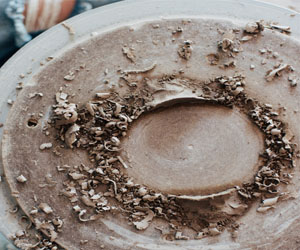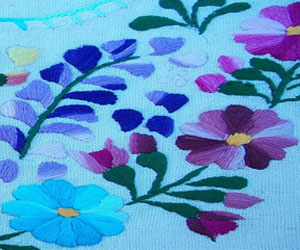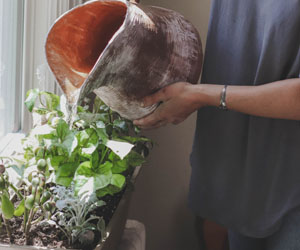


Unlocking Beauty With Natural Ingredients

In today's world, many people are reevaluating their skincare and beauty routines. A growing awareness of the potential risks associated with synthetic chemicals has prompted a shift towards natural beauty ingredients. From fruits and herbs to plant extracts and oils, nature offers a treasure trove of botanical wonders that can nourish, heal, and rejuvenate our bodies.
The Rise Of Natural Beauty Ingredients: The beauty industry has seen a surge in the use of natural ingredients. Consumers are increasingly turning to plant-based solutions that are gentle on the skin, free from harmful chemicals, and more sustainable.
Nourishing With Nature: Natural ingredients are packed with essential vitamins, antioxidants, and minerals that promote healthier skin and hair. For example, aloe vera is known for its soothing and hydrating properties, while honey is a natural humectant, helping the skin retain moisture.
Healing With Herbs: Herbs have been used for centuries in traditional medicine and beauty practices. Ingredients like chamomile, calendula, and lavender possess anti-inflammatory and healing properties, making them ideal for calming irritated skin and promoting an even complexion.
The Miracle Of Essential Oils: Essential oils are concentrated extracts from plants and are known for their therapeutic properties. Lavender, tea tree, and rosehip oils are excellent choices for skincare, offering benefits such as acne reduction, scar healing, and anti-aging effects.
Fruit Extracts: Fruits like papaya, pineapple, and citrus fruits contain natural enzymes and acids that gently exfoliate the skin, leaving it brighter and more radiant. They are commonly found in natural peels and masks.
The Green Beauty Revolution: The natural beauty movement has given rise to the concept of "green beauty." Green beauty emphasizes the use of clean, natural, and eco-friendly ingredients. Many beauty companies are now formulating products without harmful chemicals, ensuring they are safe for both individuals and the environment.
DIY Beauty: For those who prefer a hands-on approach, DIY beauty using natural ingredients is becoming increasingly popular. Homemade masks, scrubs, and serums can be easily prepared with ingredients from your kitchen or garden, allowing you to tailor them to your specific skincare needs.
Holistic Approach: Natural beauty ingredients are not just about external application; they can also be part of a holistic approach to health and well-being. A balanced diet rich in fruits and vegetables can improve skin and hair health from the inside out.
Sustainability Matters: Choosing natural beauty ingredients often aligns with a commitment to sustainability. Eco-conscious consumers prefer products that utilize eco-friendly practices and packaging to reduce their environmental impact.
The Future Of Beauty: As the natural beauty movement continues to grow, the future of skincare and beauty looks brighter and healthier. With a deeper understanding of natural beauty ingredients and their benefits, individuals can make informed choices that promote their well-being while reducing their exposure to harsh chemicals.
The use of natural beauty ingredients is a testament to the power of nature in enhancing our beauty and well-being. Whether you choose to embrace natural beauty in your skincare routine or explore the world of green beauty products, you'll be tapping into the age-old wisdom of botanical wonders that have been trusted for generations. This return to nature is not just a trend but a lifestyle that is bound to leave you with healthier, more radiant skin and hair.
Shaping Civilizations From Clay
 Neolithic Advancements: The Neolithic period (circa 10,000 to 2,000 BCE) marked a significant leap in the history of pottery. During this time, humans developed agriculture, leading to the need for more efficient food storage and preparation. This spurred the refinement of pottery techniques and the introduction of pottery wheels for shaping clay. Various cultures worldwide, from ancient China to Mesopotamia, independently discovered pottery and ceramic techniques that would continue to evolve over the millennia.
Neolithic Advancements: The Neolithic period (circa 10,000 to 2,000 BCE) marked a significant leap in the history of pottery. During this time, humans developed agriculture, leading to the need for more efficient food storage and preparation. This spurred the refinement of pottery techniques and the introduction of pottery wheels for shaping clay. Various cultures worldwide, from ancient China to Mesopotamia, independently discovered pottery and ceramic techniques that would continue to evolve over the millennia.
Egypt And Mesopotamia: Two of the world's earliest advanced civilizations, Egypt and Mesopotamia, played pivotal roles in the history of pottery. In ancient Egypt, pottery was not only used for practical purposes but also for religious and artistic expression. The Egyptians produced ornate and finely glazed ceramics, including funerary objects and sculptures.
In Mesopotamia, the cradle of civilization, clay tablets were employed for writing, while pottery was used to store and transport valuable commodities. The invention of the potter's wheel in this region revolutionized ceramic production and allowed for greater consistency and intricacy in design.
Greek And Roman Contributions: The Greeks elevated pottery to an art form. Their beautifully painted pottery, featuring intricate designs and intricate depictions of daily life and mythology, are now highly sought-after by collectors and historians. Greek pottery remains an enduring legacy of their artistic achievements.
The Romans continued the tradition of fine ceramic work, adopting Greek influences and creating their own distinctive styles. Roman pottery production was highly organized, and their ceramics were traded and exported throughout the vast Roman Empire.
The Far East: In China, pottery and porcelain have an ancient history that spans thousands of years. Chinese ceramics are celebrated for their craftsmanship, innovation, and exquisite glazes.
Crafting Creativity And Fulfillment
 Sense Of Accomplishment: There's a profound sense of accomplishment that comes with completing a woodworking project. The act of seeing your vision take shape, from the initial design to the final finished piece, is incredibly rewarding. It builds confidence and self-esteem, and each project serves as a tangible testament to your skills and dedication.
Sense Of Accomplishment: There's a profound sense of accomplishment that comes with completing a woodworking project. The act of seeing your vision take shape, from the initial design to the final finished piece, is incredibly rewarding. It builds confidence and self-esteem, and each project serves as a tangible testament to your skills and dedication.
Learning And Growth: Woodworking as a hobby is a journey of continuous learning and growth. It's an opportunity to acquire new skills and techniques, from mastering joinery methods to understanding different types of wood. The learning curve is steep, but the journey is part of the joy, as you gradually progress from simple projects to more complex creations.
Customization And Personalization: One of the most appealing aspects of woodworking as a hobby is the ability to customize and personalize your creations. You can design and build items that fit your specific needs and preferences. Whether it's crafting a piece of furniture that matches your home decor or constructing a gift that resonates with a loved one, woodworking empowers you to create truly unique and meaningful pieces.
Community And Camaraderie: Woodworking enthusiasts often find a supportive and like-minded community. Whether you're sharing your latest project with fellow hobbyists at a woodworking club, participating in online forums, or attending workshops, the sense of camaraderie and shared passion is a cherished aspect of the hobby.
Preserving Tradition And Heritage: Woodworking as a hobby allows individuals to carry forward traditions and heritage. Many woodworking techniques have been passed down through generations, and by engaging in this craft, you become a part of this rich legacy, preserving and passing on valuable knowledge.
The Art Of Crewel Embroidery
 A Stitch In Time: The History Of Crewel Embroidery
A Stitch In Time: The History Of Crewel Embroidery
Crewel embroidery has a storied history that dates back over a thousand years. The word "crewel" is believed to have originated from the Old French word "croisel," which referred to a piece of metal or a slender wire used for embroidery. Crewelwork gained prominence in Europe during the 16th and 17th centuries and was particularly associated with England.
Characteristics Of Crewel Embroidery:
Crewel embroidery is known for its distinct characteristics, which set it apart from other embroidery techniques:
Use Of Crewel Wool: Crewel wool, a fine and twisted two-ply yarn, is the primary thread used in this technique. Its thickness and texture lend depth and dimension to the designs.
Raised Surface Stitches: Crewel embroidery often employs raised or padded stitches. These give the designs a textured, three-dimensional quality.






Decorating Your Herb Garden
 Symmetrical Or Geometric Layouts: Create symmetrical or geometric patterns in your garden, such as circular herb beds or rectangular planters. These structured designs can bring a sense of order and formality to your garden.
Symmetrical Or Geometric Layouts: Create symmetrical or geometric patterns in your garden, such as circular herb beds or rectangular planters. These structured designs can bring a sense of order and formality to your garden.
Herb Borders: Plant herbs along the edges of garden beds or walkways to define the space and create an organized, neat appearance.
Decorative Planters And Containers
Your choice of planters and containers can be a focal point in your herb garden:
Terracotta Pots: The rustic charm of terracotta pots adds a timeless elegance to your garden. Consider using pots of various sizes and shapes for a curated look.
Decorative Containers: Opt for unique and decorative containers like vintage crates, wooden barrels, or painted ceramics. These containers can be both functional and ornamental.
Hanging Baskets: Hang herbs in decorative baskets, allowing them to cascade gracefully. This not only saves space but also adds a touch of whimsy to your garden.
Vertical Planters: Vertical herb planters, such as living walls or pocket planters, are not only space-efficient but also create a captivating visual display.
Garden Decor And Art
Incorporating garden decor and art pieces can enhance the visual appeal of your herb garden:
Garden Statues: Statues, sculptures, or even ornamental birdbaths can be strategically placed to create a focal point or add a sense of character to your garden.
Garden Signs: Customize herb labels or garden signs with artistic fonts and designs. These signs serve a functional purpose while adding a touch of charm.
Crafting Innovation In A Glass
 The Rise Of The Microbrewery: The microbrewery movement gained momentum in the late 20th century as a response to the dominance of large, corporate breweries. These passionate and entrepreneurial brewers sought to reintroduce diversity and flavor into a beer market that had become inundated with mass-produced, homogenized brews.
The Rise Of The Microbrewery: The microbrewery movement gained momentum in the late 20th century as a response to the dominance of large, corporate breweries. These passionate and entrepreneurial brewers sought to reintroduce diversity and flavor into a beer market that had become inundated with mass-produced, homogenized brews.
Independent Spirit And Innovation: Microbreweries thrive on their independent spirit. They are often born out of a brewer's desire to experiment, push boundaries, and craft beers that are unique and distinct. This spirit of innovation has led to a remarkable range of beer styles and flavor profiles that cater to every taste preference. From hoppy IPAs to rich stouts and sours, microbreweries offer a diverse array of options for beer enthusiasts.
Craftsmanship And Quality: One of the cornerstones of microbreweries is their unwavering commitment to quality. Brewmasters at these small establishments are deeply involved in every step of the brewing process, from selecting the finest ingredients to meticulously monitoring each batch. The focus on craftsmanship ensures that the beer produced is of the highest quality.
Community And Local Engagement: Microbreweries are not just places to brew and enjoy beer; they often serve as community hubs. Local microbreweries foster a sense of belonging, with patrons frequently interacting with brewers, learning about the brewing process, and enjoying unique, small-batch brews. They often feature taprooms, events, and tours, providing a social space where beer lovers can come together and celebrate their passion.
Economic Impact: In addition to providing a gathering place for communities, microbreweries contribute significantly to the local economy. They create jobs, source ingredients locally when possible, and attract tourists to the area. The craft beer industry has also led to the growth of related businesses, such as craft beer bars, restaurants, and beer tourism.